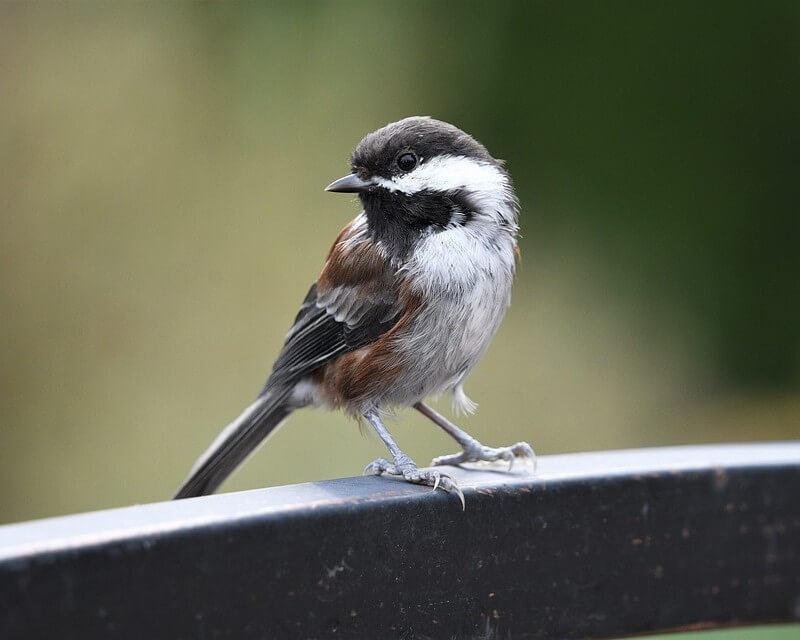From San Diego to San Francisco, the Golden State is home to some incredible birds. With 703 species observed on ebird, California’s changing seasons and vast geography provide for a diverse habitat. In this post, we’ll review 30 of the most common and colorful birds in California along with some helpful data on when and where to find them.
We even sampled 5 years of aggregate data from ebird’s California checklists to compile easy-to-use statistics and graphs to help identify each bird species. So whether you’re just watching the backyard bird feeder or venturing to birding hotspots like Furnace Creek Ranch or Huntington Central Park – we’ll have you ready to start bird watching like a professional.
Acorn Woodpecker

The Acorn Woodpecker is a year-round resident of California.
- Melanerpes formicivorus
- Size: 8″ (21cm)
- CA Checklist Frequency High: 22% in April
- CA Checklist Frequency Low: 15% in February
Identification and Color: The Acorn Woodpecker is mostly black, with some white patches on its face and white to gray undersides. A dominant black patch around the bill and a striking red on top. Females tend to have less red than males. They have short and pointed bills.
Habitat and Behavior: Found on the west coast and some southwest states. The Acorn Woodpecker makes oak trees their homes and is rarely found away from those trees. Will live in large groups and store their acorns in holes they’ve created in the oaks.
Diet: As the name implies, the Acorn Woodpecker enjoys acorns but will also eat insects, fruits, and seeds.
American Kestrel

The American Kestrel can be seen year-round in California.
- Falco sparverius
- Size: 9″ (23cm)
- CA Checklist Frequency High: 17% in December
- CA Checklist Frequency Low: 5% in May
Identification and Color: Known as the smallest falcon. They have intricate patterns and multiple colors. Their bodies are covered with black spots. The male’s body has a top color of rusty red, then a grey or blue strip, then white. A female is red and white without the blue-grey stripe. Both sexes have black slash marks on their heads.
Habitat and Behavior: Found throughout the United States and some parts of Canada. Their habitat can vary but they prefer open spaces and perching high up above the ground. Will often spot prey from their high perch and swoop down on it.
Diet: The American Kestrel will feed on large insects such as grasshoppers or beetles. They will also catch small mammals or reptiles.
American Robin
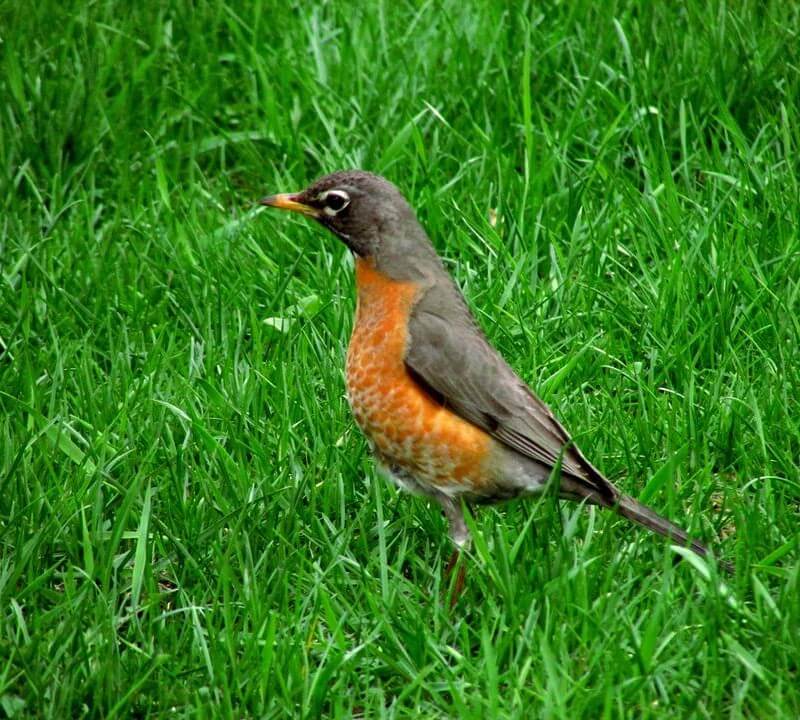
Abundant throughout the entire country and commonly a welcome indicator of spring in northern states. The American Robin is a common sight in California.
- Turdus migratorius
- Size: 9-11″ (22.5-28cm)
- CA Checklist Frequency High: 26% in June
- CA Checklist Frequency Low: 10% in September
Identification and Color: Reddish-brown breast (almost looks pot-bellied) and grey back. The female usually has a lighter plumage than the male. Males have a darker black head.
Habitat and Behavior: The American Robin is found in open woodlands, gardens, and parks. It often forages for food on the ground cocking its head to the side in an effort to find worms. When it’s not eating, the American Robin can often be seen perched on a branch singing its cheerful song.
Diet: The American Robin feeds on insects, worms, berries, and fruits.
Anna’s Hummingbird

Anna’s Hummingbird is seen year-round in California.
- Calypte anna
- Size: 4″ (10 cm)
- CA Checklist Frequency High: 48% in September
- CA Checklist Frequency Low: 34% in June
Identification and Color: Growing to only 4 inches in length, Anna’s Hummingbird is on the stocky side. They have a short, straight bill and long tail. Mostly green and grey, but males have iridescent pink around their heads. Both sexes have white on their undersides.
Habitat and Behavior: Found on the west coast year-round. Will visit feeders in gardens or parks. Can be located in open woods or by streams and rivers. They are very fast and can be hard to see while in motion. Will stop and hover over a flower or feeder to eat.
Diet: Anna’s Hummingbird diet consists of nectar and tiny insects.
Black Phoebe

The Black Phoebe can be seen year-round in California.
- Sayornis nigricans
- Size: 7″ (17 cm)
- CA Checklist Frequency High: 55% in September
- CA Checklist Frequency Low: 32% in June
Identification and Color: The Black Phoebe has a dark black at the top of the head, going into a dark and light gray, to a stark white belly patch. They have large heads and squared tails. Their bills are straight, pointed, and small. Full-grown adults are still very small.
Habitat and Behavior: Found through the west coast, south, and into Mexico. Preferring to be by water, the west coast residents are usually by the Pacific Ocean and other locations will be by a stream or other water source. They will perch waiting to make a short flight when an insect is spotted.
Diet: The Black Phoebe mainly eats insects, but will sometimes go after small fish.
Brewer’s Blackbird

The Brewer’s Blackbird is a year-round resident of California.
- Euphagus cyanocephalus
- Size: 10″ (25 cm)
- CA Checklist Frequency High: 14% in June
- CA Checklist Frequency Low: 8% in February
Identification and Color: Males and females have different colors. Males are dark black with a blue-green sheen and a light yellow eye. Females are brown with darker shades of brown on their wings and tail and have dark-colored eyes. Both have fairly long legs, long tail feathers, and a long, thick bill.
Habitat and Behavior: Can be spotted in many places. Usually, permanent residents of the west, will breed in the north, migrate through the east and spend winter in the south. When flying they can be seen rising higher or dropping low and may circle before stopping. May also be found in residential areas.
Diet: The Brewer’s Blackbird will eat a wide variety of insects, some seeds, and berries when available in the summer.
California Scrub-Jay

The California Scrub-Jay can be seen year-round in California.
- Aphelocoma californica
- Size: 11″ (28 cm)
- CA Checklist Frequency High: 39% in September
- CA Checklist Frequency Low: 28% in July
Identification and Color: The California Scrub-Jay has a rich blue and grey color on top with lighter white undersides. Depending on the lighting, the blue color can look very dark. A long tail and straight bill with a slight hook at the end of it.
Habitat and Behavior: Found on the west coast and a permanent resident of California as the name suggests. They can be found in open forests of oak and riverside woods. Often found perched very high up, they will forage in trees or on the ground.
Diet: The California Scrub-Jay has an omnivorous diet dependent on the season. Insects in the summer and seeds, nuts, and berries in the winter.
Cliff Swallow

The Cliff Swallow can be seen during the summer months in California.
- Petrochelidon pyrrhonota
- Size: 6″ (15 cm)
- CA Checklist Frequency High: 20% in May
- CA Checklist Frequency Low: 0% in Winter
Identification and Color: The Cliff Swallow has a brown head with black at the very top and a white forehead patch. In proper light, their backs will have a metallic shine on their dark blue feathers. White underparts with brown wings and tails. Rounded wings and a medium-length tail. They have a very short, pointed bill.
Habitat and Behavior: Breeds all over the United States, Canada, and up to Alaska. A very long-distance migrant bird that will go all the way to southern South America. Will build their nests on upright surfaces like cliffs, bridges, or culverts. Will catch insects on wings for foraging.
Diet: The Cliff Swallow enjoys a wide variety of insects, including many flying insects such as bees, wasps, and flies. They will occasionally eat berries.
Dark-eyed Junco

The Dark-eyed Junco is a small, sparrow-like bird that is one of California’s most common winter birds.
- Junco hyemalis
- Size: 6″ (15 cm)
- CA Checklist Frequency High: 29% in December
- CA Checklist Frequency Low: 16% in August
Identification and Color: Rounded dark head and eyes. Charcoal back and white breast.
Habitat and Behavior: Enjoys a variety of wooded habitats throughout Canada and the northern United States. Dark-eyed Juncos are typically found in open woods, forest edges, weedy fields, and backyards. In winter they often form flocks and can be seen feeding on the ground beneath bird feeders.
Diet: Dark-eyed Juncos eat mostly insects and seeds.
European Starling

The European Starling is native to Europe but was introduced to North America in the late 1800’s. Considered an invasive species, they are a common backyard bird in California.
- Sturnus vulgaris
- Size: 8.5″ (22 cm)
- CA Checklist Frequency High: 30% in April
- CA Checklist Frequency Low: 13% in July
Identification and Color: Small, stocky black birds with glossy feathers and a slender pointed bill. Speckled with white spots.
Habitat and Behavior: European starlings can be found in woods, fields, and other open areas. They often build their nests in trees or holes in buildings. European starlings are also known for their elaborate vocalizations, often imitating the sounds of other birds.
Diet: European starlings are opportunistic eaters and will feed on a variety of insects, fruits and seeds.
House Finch

The House Finch is a common bird across North America, seen year-round in California.
- Carpodacus mexicanus
- Size: 5″ (13 cm)
- CA Checklist Frequency High: 56% in May
- CA Checklist Frequency Low: 40% in January
Identification and Color: Fairly small, measuring only about 5-6 inches long. House Finches are relatively easy to identify thanks to their characteristic red plumage near the eyes and throat. Males are typically redder than females, but both genders have distinctive streaks on their breast and belly.
Habitat and Behavior: House Finches are found in a variety of habitats, including woods, gardens, and open fields. A rather social bird that often travels in flocks. Can often be seen perching on power lines or fences in suburban areas.
Diet: House Finches are primarily seed eaters, but they will also consume insects and fruit on occasion.
House Sparrow

One of the most common backyard birds in California. The House Sparrow is seen year-round.
- Passer domesticus
- Size: 6″ (15 cm)
- CA Checklist Frequency High: 19% in May
- CA Checklist Frequency Low: 10% in September
Identification and Color: A small plump bird with brown feathers and a grayish-plain breast. They have a black stripe on their face that extends from their bill to their throat. Wings are streaked with black and white.
Habitat and Behavior: Found in open areas with some trees nearby, such as farmland, parks, and suburban neighborhoods. They build their nests in holes in tree trunks or in man-made structures such as gutters, light fixtures, and nest boxes. House Sparrows are social birds that often form large flocks. You won’t be surprised to see them downtown near restaurants with outdoor seating!
Diet: House Sparrows eat mostly seeds and grains, but will also eat insects, berries, and other fruits. Happy to pick up crumbs and left over human food where available.
Killdeer

The Killdeer is typically seen in California during the warmer months.
- Charadrius vociferous
- Size: 10″ (25 cm)
- CA Checklist Frequency High: 17% in September
- CA Checklist Frequency Low: 10% in February
Identification and Color: Mostly brown on the head and top of the body. The head is marked with black and white patches. A white underpart with two black stripes across it. An orange tail part can be seen when in flight. The Killdeer has a long tail and long wings. A small and short bill.
Habitat and Behavior: Located throughout North America. Southern birds are mostly permanent residents and northern birds will migrate. Killdeer like to be in very open areas of lawns, fields, and coastline. Spends the majority of time on the ground running around.
Diet: Insects make up the bulk of their diet. Beetles, grasshoppers, and caterpillars are frequent favorites. They may also eat a small number of seeds.
Lesser Goldfinch

The Lesser Goldfinch is a year-round resident of California.
- Spinus psaltria
- Size: 5″ (13 cm)
- CA Checklist Frequency High: 37% in April
- CA Checklist Frequency Low: 22% in December
Identification and Color: Males have black on top of their heads and bodies. They have a bright yellow underpart and white bars on their wings. Females have a dark top, but not black and yellow underparts that are duller than the males. These birds have short tails and long wings. They have a very short bill.
Habitat and Behavior: Found in the southern midwest and west. Mostly permanent residents in their locations, but northern birds may migrate further south. Likes to be in weedy fields, brushy areas, and can be close to streams. Can be in extremely large groups and may mix with other bird species.
Diet: The Lesser Goldfinch will eat mostly seeds but some insects too.
Loggerhead Shrike

The Loggerhead Shrike can be seen year-round in California.
- Lanius ludovicianus
- Size: 10″ (25 cm)
- CA Checklist Frequency High: 5% in November
- CA Checklist Frequency Low: 1% in Summer
Identification and Color: The Loggerhead Shrike has grey at the very top of the head and going down some of the back, then they have white and black wing and tail feathers. They have a large black stripe across their face at their eyes and white directly underneath that that goes around their bellies. They have long and rounded tails. A thick bill with a slight hook.
Habitat and Behavior: Found throughout the southern half of the States, some are also found in the north-central part for the breeding season. Can be found in somewhat open or denser areas. Will forage from a low and exposed perch.
Diet: Loggerhead Shrike will eat large insects like grasshoppers and crickets. They can also eat some small rodents like mice.
Mourning Dove

Mourning Doves are one of the most common birds in North America, and they can be found in a variety of habitats throughout California.
- Zenaida macroura
- Size: 12″ (30 cm)
- CA Checklist Frequency High: 47% in May
- CA Checklist Frequency Low: 25% in November
Identification and Color: These slender birds have long, pointed tails and a tiny head. Brown and pale gray plumage with darker streaks on the wings and back.
Habitat and Behavior: Mourning Doves are relatively quiet birds, but they can often be heard cooing softly. Mourning Doves typically nest in trees, but they will also use man-made structures such as window ledges and gutters.
Diet: The Mourning Dove primarily eat seeds, but they will also eat insects and berries
Northern Flicker
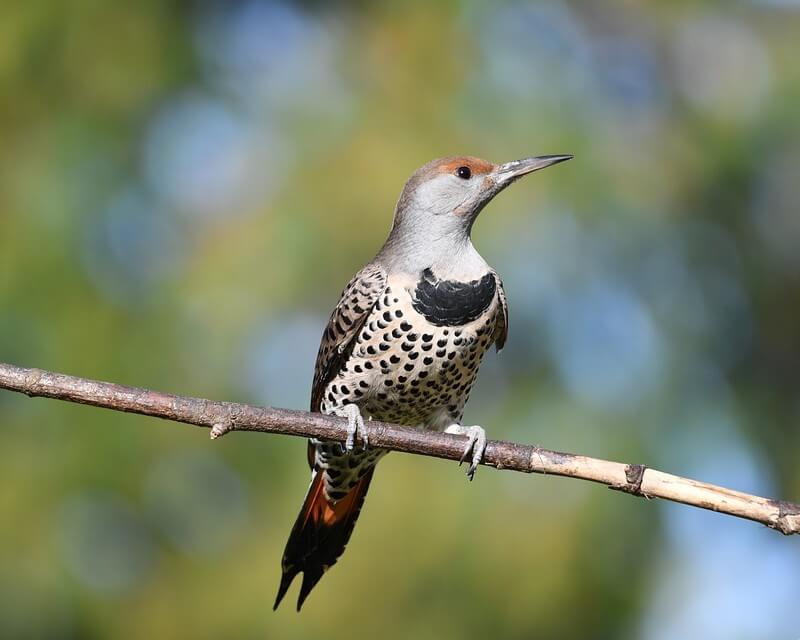
The Northern Flicker is seen year-round in California.
- Colaptes auratus
- Size: 12″ (30 cm)
- CA Checklist Frequency High: 29% in October
- CA Checklist Frequency Low: 9% in September
Identification and Color: A fairly common large woodpecker, but size is where the similarities to other woodpeckers end. The male Northern Flicker is unique with a brown back, black bars and spotted breast. All North American Flickers have white rumps. There are also two different color groups of Northern Flickers – Yellow-shafted and Red-shafted. Yellow-shafted flickers have yellow underwings. Red-shafted flickers have reddish pink underwings.
Habitat and Behavior: Northern Flickers are hole-nesting birds, often making a home in a dead tree. Can be seen hopping around the ground while foraging or latched onto a tree eyeing a spot to search for food.
Diet: Northern Flickers mainly eat insects off the ground, but will also eat berries and nuts.
Northern Mockingbird

The Northern Mockingbird is a common sight in California, known for its distinctive song and plumage.
- Mimus polyglottos
- Size: 10″ (25 cm)
- CA Checklist Frequency High: 27% in April
- CA Checklist Frequency Low: 16% in September
Identification and Color: Northern Mockingbirds are mostly gray in color with white patches on the wings and tail. They have a long black bill and yellow eyes.
Habitat and Behavior: Northern Mockingbirds are found in open habitats such as parks, woods edges, and suburban backyards. They are active throughout the day and are known for their territorial behavior, often chasing away other birds or small animals that come too close to their nest. The Northern Mockingbird is a bit of a joker with its constant imitating of other bird calls.
Diet: Northern Mockingbirds mainly eat insects, but will also eat fruits and berries in the winter.
Nuttal’s Woodpecker
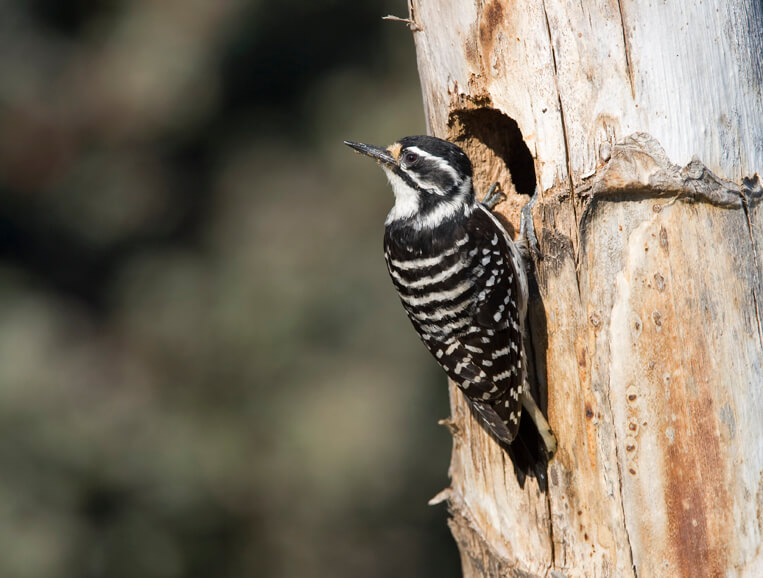
The Nuttal’s Woodpecker can be seen year-round in California.
- Picoides nuttallii
- Size: 7″ (18 cm)
- CA Checklist Frequency High: 24% in September
- CA Checklist Frequency Low: 15% in February
Identification and Color: Males and females both have black and white striping throughout their bodies with some solid white underparts and some black spotting on the side of that. Both sexes have 2 narrow stripes on their heads. The main difference is males have a bright red patch on the top and very backs of their heads.
Habitat and Behavior: The Nuttal’s Woodpecker is located in the western half of California. They are permanent residents there and rarely go far from the nests they make. Specifically prefer to be in oak trees but may also be in cottonwood, sycamores, or willows. Foraging takes place in the trees mainly.
Diet: Nuttal’s Woodpeckers mainly eat insects they find in and around the trees. Will also eat some nuts, fruits, seeds, and berries.
Oak Titmouse
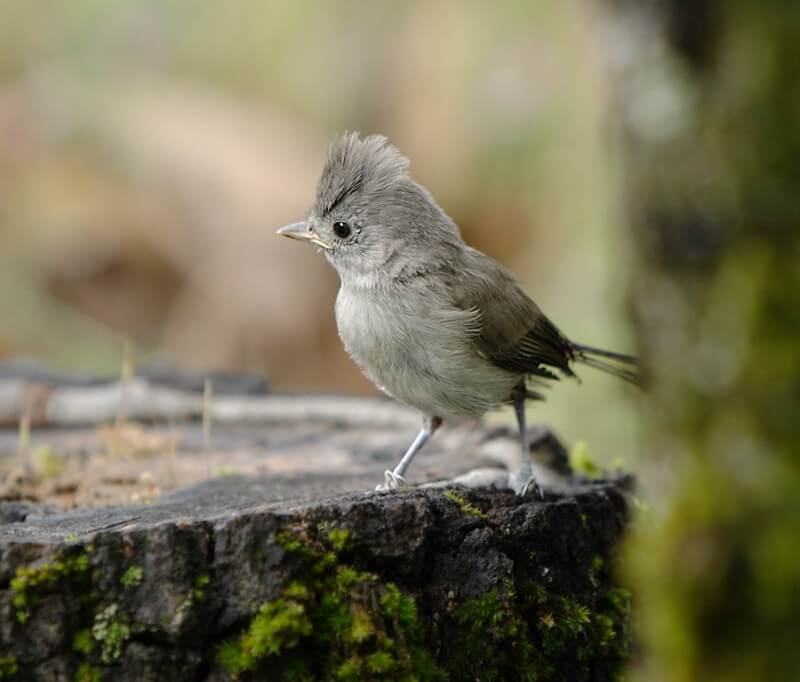
The Oak Titmouse is a year-round resident of California.
- Baeolophus inornatus
- Size: 5″ (13 cm)
- CA Checklist Frequency High: 19% in December
- CA Checklist Frequency Low: 15% in January
Identification and Color: The Oak Titmouse is plain brown and grey overall. They may have some darker shading at the top of their heads and bodies. T hey have a slight crest at the top of their head. They have short and stubby bills. A medium-length tail.
Habitat and Behavior: Found only on the west coast. The Oak Titmouse will mostly be found in oak trees but sometimes can be found in oak and pine forests. Very active birds that are consistently in movement. They forage by hopping around trees and can hang upside down.
Diet: Seeds, nuts, and insects make up their diet. They will eat acorns, weed seeds, and sometimes small fruits or berries.
Red-winged Blackbird

The Red-winged Blackbird is a year-round resident of California, especially near water areas.
- Agelaius phoeniceus
- Size: 8.5″ (22 cm)
- CA Checklist Frequency High: 23% in May
- CA Checklist Frequency Low: 10% in August
Identification and Color: A small black bird with a striking appearance. The male has black feathers and a red patch on each wing, while the female is mostly dark brown with vertical streaks.
Habitat and Behavior: These birds are found in open areas such as marshes, meadows, and fields. Often seen near water, where they build their nests. Red-winged Blackbirds are social birds and often form large flocks.
Diet: The Red-winged Blackbird diet consists of insects, spiders, and other small invertebrates. Will also eat seeds, fruits, and berries.
Ruby-crowned Kinglet

The Ruby-crowned Kinglet is commonly seen in California during the spring and fall months.
- Regulus calendula
- Size: 4″ (11 cm)
- CA Checklist Frequency High: 40% in December
- CA Checklist Frequency Low: 1% in Summer
Identification and Color: The Ruby-crowned Kinglet has an olive green body with somewhat lighter underparts. They have white eye-rings and on males, the ruby red crest is only occasionally able to be seen. White and black wing bars. They are small birds with large heads and no necks. Very thin and straight bills.
Habitat and Behavior: Will breed very far north and migrates to spend the winter in the south. They like to be in tall and dense forests. Favor coniferous in the summer and deciduous in the winter because of their location. Very energetic birds that are constantly flicking their wings. They forage at many levels in the trees.
Diet: In summer the Ruby-crowned Kinglet feeds mainly on insects. During winter they will eat some berries and seeds.
Savannah Sparrow

The Savannah Sparrow is seen year-round in California.
- Passerculus sandwichensis
- Size: 6″ (15 cm)
- CA Checklist Frequency High: 13% in November
- CA Checklist Frequency Low: 3% in May
Identification and Color: The tops of their bodies are streaked with browns, whites, and blacks. They have a crown of similar colors that are raised slightly. Underparts are lighter and white with streaks at the top and plain towards the belly. They have a yellow patch near their eye.
Habitat and Behavior: Breeds throughout Alaska, Canada, and the northern United States. Will migrate for the winter to the west coast, central south, and southeastern states. Prefers open areas with light vegetation like fields and meadows. Will forage on the ground or low shrubs.
Diet: The Savannah Sparrow mainly eats insects and seeds. They will eat beetles, grasshoppers, and spiders. Will also eat some berries.
Spotted Towhee

The Spotted Towhee can be seen year-round in California.
- Pipilo maculatus
- Size: 8″ (20 cm)
- CA Checklist Frequency High: 30% in May
- CA Checklist Frequency Low: 16% in August
Identification and Color: Males have black upperparts with spotted white on their backs. Females are gray-brown with the same spot pattern on their backs. Both sexes have a red-brown patch with white bellies. They have long rounded tails with white tips. Thick and pointed bills.
Habitat and Behavior: Found mainly in the Great Plains and the west half of the United States. Birds in the central north often migrate, and many are permanent residents of the south and west. Like to be in open areas that have a lot of shrubs and thick undergrowth. Mainly forages on the ground.
Diet: The Spotted Towhee eats insects, seeds, and berries. Their diet is dependent on the season with insects being eaten in the summer and seeds and berries in the winter.
Western Bluebird

The Western Bluebird is seen year-round in California.
- Sialia mexicana
- Size: 7″ (18 cm)
- CA Checklist Frequency High: 20% in April
- CA Checklist Frequency Low: 13% in August
Identification and Color: Western Bluebird males have blue heads, wings, and tail feathers. They have an orange-brown chest and lighter belly area. Females are more grey with some blue tinge to their wings and tail. They also have a lighter orange-brown chest patch. Fairly small birds with short tails and have thin, straight bills.
Habitat and Behavior: Found in the west, most northern birds migrate and southern birds stay permanently. Like to be in open woodlands with either deciduous or coniferous trees. Can also be found in farmlands or mountainous areas. Very social birds and can be a part of big flocks. Will forage low to the ground and can catch insects mid-air.
Diet: Western Bluebirds enjoy insects like grasshoppers, caterpillars, and beetles make up the bulk of their diet.
Western Kingbird

The Western Kingbird can be seen during the warmer months in California.
- Tyrannus verticalis
- Size: 9″ (23 cm)
- CA Checklist Frequency High: 13% in May
- CA Checklist Frequency Low: 0% in Winter
Identification and Color: The Western Kingbird has a grey head with a white throat and chest. They have bright yellow bellies. Their wings are brown and their tails are black with white outlines. Long wings and square-tipped tails. Their bills are straight and heavy.
Habitat and Behavior: They are found in the western half of the United States during the summer. Migrates far south in the winter and some to Florida. They like open areas like grasslands or desert areas. Very territorial and will defend their areas. They forage by watching from their perch which can be either high or low.
Diet: The Western Kingbird mostly eats insects, wasps, bees, and beetles. May eat a small number of berries and fruits.
Western Meadowlark

The Western Meadowlark is commonly seen during warmer months in California.
- Sturnella neglecta
- Size: 9″ (23 cm)
- CA Checklist Frequency High: 13% in November
- CA Checklist Frequency Low: 2% in August
Identification and Color: A bright yellow underpart that is marked with a black V in the summer and grey in the winter. Heavily streaked with brown, white, and black over their heads, top bodies, wings, and tails. They have short stiff tails and rounded wings. Bills are slender and long. They range about 6 to 9 inches in length.
Habitat and Behavior: The Western Meadowlark is a permanent resident in much of the west and midwest, the north-central states will see the birds migrate. Likes to be in open areas of grasslands and farms. Generally alone or in loose flocks. Will forage on the ground.
Diet: Insects and seeds make up the Western Meadowlarks’ diet.
White-breasted Nuthatch

The White-breasted Nuthatch can be found year-round in California.
- Sitta carolinensis
- Size: 6″ (15 cm)
- CA Checklist Frequency High: 13% in September
- CA Checklist Frequency Low: 9% in May
Identification and Color: A stocky short-tailed bird. Has a black cap above an all white face and breast. Blueish upper parts.
Habitat and Behavior: The White-breasted Nuthatch can be found in forests, woodlands, and parks. Known for its acrobatic abilities, it can easily move up, down, and sideways on trees.
Diet: The White-breasted Nuthatch feeds on insects, spiders, and small nuts. Relies on seeds in the winter and will often cache them in a crevice for a later date.
White-crowned Sparrow

The White-crowned Sparrow is most often seen during the winter months in California.
- Zonotrichia leucophrys
- Size: 6″ (15 cm)
- CA Checklist Frequency High: 56% in October
- CA Checklist Frequency Low: 6% in August
Identification and Color: Most White-crowned Sparrows have black and white stripes around their head. The underpart is gray. They have brown, black, and white coloring on their wings and tail. They have small, pointed bills. Long tails and rounded wings.
Habitat and Behavior: Breeds in the very far north and spends the winter in the very far south. Likes brushy places that are mixed with open and grassy areas. Usually stays low to the ground. Usually forages on the ground or in low shrubs. They usually forage in flocks.
Diet: The White-crowned Sparrow mainly enjoys seeds from weeds or grasses. Will also eat some vegetable matter and insects.
Yellow-rumped Warbler

The Yellow-rumped Warbler is most commonly seen in California during the spring and fall.
- Dendroica coronata
- Size: 6″ (15 cm)
- CA Checklist Frequency High: 58% in October
- CA Checklist Frequency Low: 3% in September
Identification and Color: A small warbler with a soft song, all Yellow-rumped Warblers have a patch of yellow on their sides and rump (hence the name).
Habitat and Behavior: The Yellow-rumped Warbler is typically seen in large flocks during migration in the spring and fall. Enjoys larger open wooded areas as well as brush and thickets. Most often found in trees bearing needles and cones.
Diet: Enjoys insects and berries. Difficult to attract to feeders.
Conclusion
In conclusion, California is home to a wide variety of backyard birds. From the iconic California Scrub Jay to the colorful Anna’s Hummingbird, there is something for everyone to enjoy. With a little bit of knowledge and patience, anyone can become an expert backyard birder in California. Be sure to check out our other articles about common birds in California:
Remember to keep that feeder full and have your checklist ready! Before you go, take a moment to review some of our favorite California birding resources:
